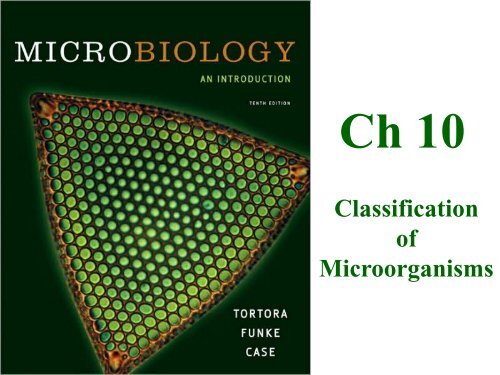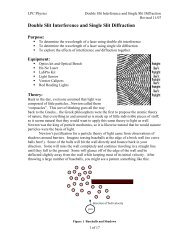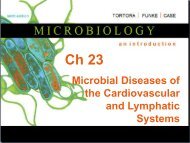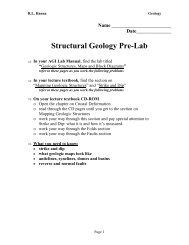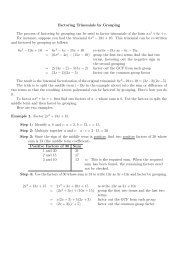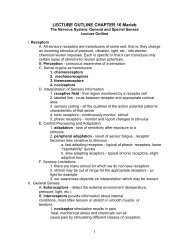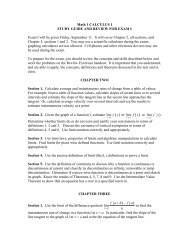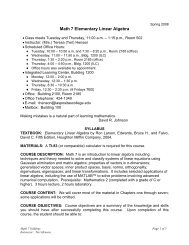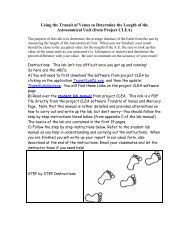Classification of Microorganisms
Classification of Microorganisms
Classification of Microorganisms
You also want an ePaper? Increase the reach of your titles
YUMPU automatically turns print PDFs into web optimized ePapers that Google loves.
Ch 10<br />
<strong>Classification</strong><br />
<strong>of</strong><br />
<strong>Microorganisms</strong>
Student Learning Outcomes<br />
Define taxonomy, taxon, and phylogeny.<br />
List the characteristics <strong>of</strong> the Bacteria, Archaea, and Eukarya domains.<br />
Differentiate among eukaryotic, prokaryotic, and viral species.<br />
Explain the scientific naming<br />
Differentiate between culture, clone, and strain.<br />
Compare and contrast classification and identification.<br />
Explain the purpose <strong>of</strong> Bergey’s Manual.<br />
Describe how staining and biochemical tests are used to identify bacteria.<br />
Explain how serological tests and phage typing can be used to identify an<br />
unknown bacterium.<br />
Describe how a newly discovered microbe can be classified by ribotyping,<br />
DNA fingerprinting, and PCR.<br />
Describe how microorganisms can be identified by nucleic acid<br />
hybridization, DNA chips, and FISH.<br />
Explain and apply a dichotomous key<br />
Copyright © 2006 Pearson Education, Inc., publishing as Benjamin Cummings
Taxonomy and Phylogeny<br />
Taxonmoy: Science <strong>of</strong> classifying organisms. Provides<br />
universal names for organisms.<br />
• Taxonomic categories: Taxon / Taxa<br />
Phylogeny or Systematics: Evolutionary history <strong>of</strong> group <strong>of</strong><br />
organisms.<br />
• Taxonomic hierarchy shows phylogenetic (evolutionary),<br />
relationships among organisms.<br />
• 1969: Living organisms divided into five kingdoms.<br />
• 1978: Two types <strong>of</strong> prokaryotic cells found. Prokaryotic<br />
relationships determined by rRNA sequencing.<br />
• All Species Inventory (2001–2025)<br />
Copyright © 2006 Pearson Education, Inc., publishing as Benjamin Cummings
The Three-Domain System<br />
Foundation Fig 10.1<br />
Copyright © 2006 Pearson Education, Inc., publishing as Benjamin Cummings
Level Above Kindom: The Three-Domain System<br />
Carl<br />
Woese<br />
1978<br />
Eubacteria (virtuosos)<br />
Archaea (weirdoes)<br />
Eukarya (predators and thieves)<br />
Copyright © 2006 Pearson Education, Inc., publishing as Benjamin Cummings
Endosymbiotic Theory: Origin <strong>of</strong> Eukaryotes<br />
Figs 10.2, 10.3<br />
Copyright © 2006 Pearson Education, Inc., publishing as Benjamin Cummings<br />
Cyanophora paradoxa: modern example <strong>of</strong><br />
possible evolutionary process
Scientific Nomenclature<br />
Common names<br />
• Vary with languages<br />
• Vary with geography<br />
Binomial Nomenclature (genus + specific epithet)<br />
• Used worldwide<br />
• Escherichia coli<br />
• Homo sapiens<br />
Copyright © 2006 Pearson Education, Inc., publishing as Benjamin Cummings
Scientific Names<br />
Scientific Binomial<br />
Source <strong>of</strong> Genus<br />
Name<br />
Source <strong>of</strong><br />
Specific Epithet<br />
Klebsiella pneumoniae Honors Edwin Klebs The disease<br />
Pfiesteria piscicida Honors Lois Pfiester Disease in fish<br />
Salmonella<br />
typhimurium<br />
Streptococcus<br />
pyogenes<br />
Penicillium<br />
chrysogenum<br />
Trypanosoma cruzi<br />
Honors Daniel Salmon<br />
Chains <strong>of</strong> cells<br />
(strepto-)<br />
Tuftlike (penicill-)<br />
Corkscrew-like<br />
(trypano-, borer;<br />
soma-, body)<br />
Stupor (typh-) in<br />
mice (muri-)<br />
Forms pus (pyo-)<br />
Produces a yellow<br />
(chryso-) pigment<br />
Honors Oswaldo<br />
Cruz
<strong>Classification</strong>: Species Definition<br />
• Eukaryotic species: A group <strong>of</strong> closely related organisms<br />
that breed among themselves<br />
• Prokaryotic species: A population <strong>of</strong> cells with similar<br />
characteristics (Bergey’s Manual <strong>of</strong> Systematic<br />
Bacteriology is standard reference on bacterial<br />
classification).<br />
• Culture: Grown in laboratory media<br />
• Clone: Population <strong>of</strong> cells derived from a single cell<br />
• Strain: Genetically different cells within a clone<br />
• Viral species: Population <strong>of</strong> viruses with similar<br />
characteristics occupying a particular ecological niche.<br />
Viruses: not placed in kingdom nor domain – not<br />
composed <strong>of</strong> cells – cannot grow without a host cell.<br />
Copyright © 2006 Pearson Education, Inc., publishing as Benjamin Cummings
Phylogenetic Relationships <strong>of</strong> Prokaryotes<br />
Copyright © 2006 Pearson Education, Inc., publishing as Benjamin Cummings Fig. 10.6
Domain Eukarya<br />
• Animalia: Multicellular; no cell walls;<br />
chemoheterotrophic<br />
• Plantae: Multicellular; cellulose cell walls;<br />
usually photoautotrophic<br />
• Fungi: Chemoheterotrophic;<br />
unicellular or multicellular; cell walls <strong>of</strong> chitin;<br />
develop from spores or hyphal fragments<br />
• Protista: A catchall kingdom for eukaryotic<br />
organisms that do not fit other kingdoms<br />
• Grouped into clades based on rRNA<br />
Copyright © 2006 Pearson Education, Inc., publishing as Benjamin Cummings
Fig 10.8<br />
<strong>Classification</strong> and<br />
Identification<br />
<strong>Classification</strong>: Placing organisms in<br />
groups <strong>of</strong> related species. Lists <strong>of</strong><br />
characteristics <strong>of</strong> known organisms.<br />
Identification: Matching characteristics<br />
<strong>of</strong> an “unknown” to lists <strong>of</strong> known<br />
organisms.<br />
Copyright © 2006 Pearson Education, Inc., publishing as Benjamin Cummings
Identifying Bacteria<br />
Copyright © 2006 Pearson Education, Inc., publishing as Benjamin Cummings<br />
Applications,<br />
p. 283
Bergey’s Manual:<br />
Classifying and Identifying Prokaryotes<br />
Bergey’s Manual <strong>of</strong><br />
Determinative Bacteriology<br />
Provides identification<br />
schemes for identifying<br />
bacteria and archaea<br />
Morphology, differential<br />
staining, biochemical<br />
tests<br />
Bergey’s Manual <strong>of</strong><br />
Systematic Bacteriology<br />
Provides phylogenetic<br />
information on bacteria and<br />
archaea<br />
Copyright © 2006 Pearson Education, Inc., publishing as Benjamin Cummings<br />
Based on rRNA<br />
sequencing
Clinical Lab Identification<br />
Morphological<br />
characteristics<br />
Useful for identifying<br />
eukaryotes<br />
Differential staining<br />
Gram staining, acidfast<br />
staining<br />
Biochemical tests<br />
Determines presence<br />
<strong>of</strong> bacterial enzymes<br />
Numerical Rapid Identification<br />
Copyright © 2006 Pearson Education, Inc., publishing as Benjamin Cummings
Serology<br />
• Involves reactions <strong>of</strong><br />
microorganisms with<br />
specific antibodies:<br />
Combine known antiserum<br />
with unknown<br />
bacterium<br />
• Useful in determining the<br />
identity <strong>of</strong> strains and<br />
species, as well as<br />
relationships among<br />
organisms.<br />
Fig 10.10: Slide Agglutination<br />
• Examples:<br />
• Slide agglutination<br />
• ELISA (see lab)<br />
• Western blot (no details)<br />
Copyright © 2006 Pearson Education, Inc., publishing as Benjamin Cummings
Phage Typing<br />
Fig 10.13<br />
Identification <strong>of</strong><br />
bacterial species<br />
and strains by<br />
determining their<br />
susceptibility to<br />
various phages.<br />
More details on<br />
bacteriophages<br />
in Ch 13<br />
Copyright © 2006 Pearson Education, Inc., publishing as Benjamin Cummings
Genetics<br />
• DNA fingerprinting:<br />
Number and sizes <strong>of</strong> DNA<br />
fragments (fingerprints)<br />
produced by RE digests are<br />
used to determine genetic<br />
similarities.<br />
• Ribotyping: rRNA sequencing<br />
• Polymerase chain reaction<br />
(PCR) can be used to amplify<br />
a small amount <strong>of</strong> microbial<br />
DNA in a sample. The<br />
presence or identification <strong>of</strong><br />
an organism is indicated by<br />
Copyright amplified © 2006 Pearson Education, DNA. Inc., (see publishing as lab) Benjamin Cummings<br />
Fig 10.14: Electrophoresis <strong>of</strong><br />
RE digest <strong>of</strong> plasmid DNA
Nucleic Acid Hybridization<br />
Single strands <strong>of</strong> DNA or RNA, from related organisms<br />
will hydrogen-bond to form a double-stranded molecule;<br />
this bonding is called nucleic acid hybridization.<br />
Examples <strong>of</strong> Applications:<br />
• Southern blotting,<br />
• DNA chips, and<br />
• FISH<br />
Copyright © 2006 Pearson Education, Inc., publishing as Benjamin Cummings<br />
Fig 10.15
Nucleic Acid Hybridization: DNA Chip<br />
Fig 10.17
Fluorescent In Situ Hybridization (FISH)<br />
Add DNA or RNA<br />
probe attached to<br />
fluorescent dye<br />
for S. aureus<br />
Fig 10.18a–b
Dichotomous Key<br />
ANIMATION Dichotomous Keys: Overview<br />
ANIMATION Dichotomous Keys: Sample with<br />
Flowchart<br />
ANIMATION Dichotomous Keys: Practice


